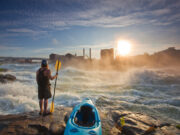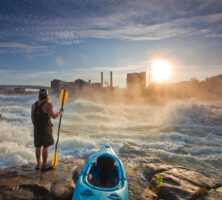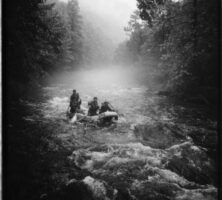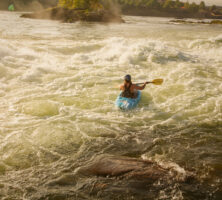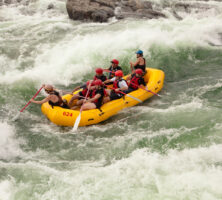Whitewater paddling is one of the fastest-growing outdoor recreational activities in the United States. Whitewater enthusiasts by the thousands have discovered that Georgia, blessed with a multitude of navigable rivers, abundant rainfall, and marked changes in elevation, is in many ways a whitewater paradise.
Whitewater paddling is a general term that may be used to describe a variety of activities. Using paddles, whitewater enthusiasts navigate nonmotorized boats through swiftly moving, or “white,” water. Several types of whitewater craft are commonly seen on Georgia’s waterways, including rafts, canoes, and kayaks. In addition to the inherent excitement offered by the sport, paddlers are drawn to whitewater paddling because it offers rigorous exercise, a chance to enjoy the spectacular scenery along the rivers, and the opportunity to observe rare plants and wildlife.
The American Whitewater Association lists more than twenty Georgia rivers, primarily in the northern mountains, as suitable for whitewater paddling. A wide range of difficulty levels is represented, from gentle ripples and occasional shoals appropriate for the novice to sheer drops of thirty feet or more, navigable only by experts. Georgia’s mild climate also makes the state an ideal paddling destination, since boaters can enjoy the sport year round with minimal protective clothing.
History
Although a handful of hardy individuals have been canoeing difficult whitewater since the 1940s and earlier, whitewater paddling did not emerge as a sport until the development of durable rafts designed for use by the military. Surplus rafts became available for civilian use after World War II (1941-45) and began to be used by recreational boaters shortly thereafter. Rafts were ideally suited for whitewater paddling because of the resiliency of the materials used in their construction—primarily reinforced rubber and plastic. These boats could withstand powerful impacts with rocks and emerge unscathed.
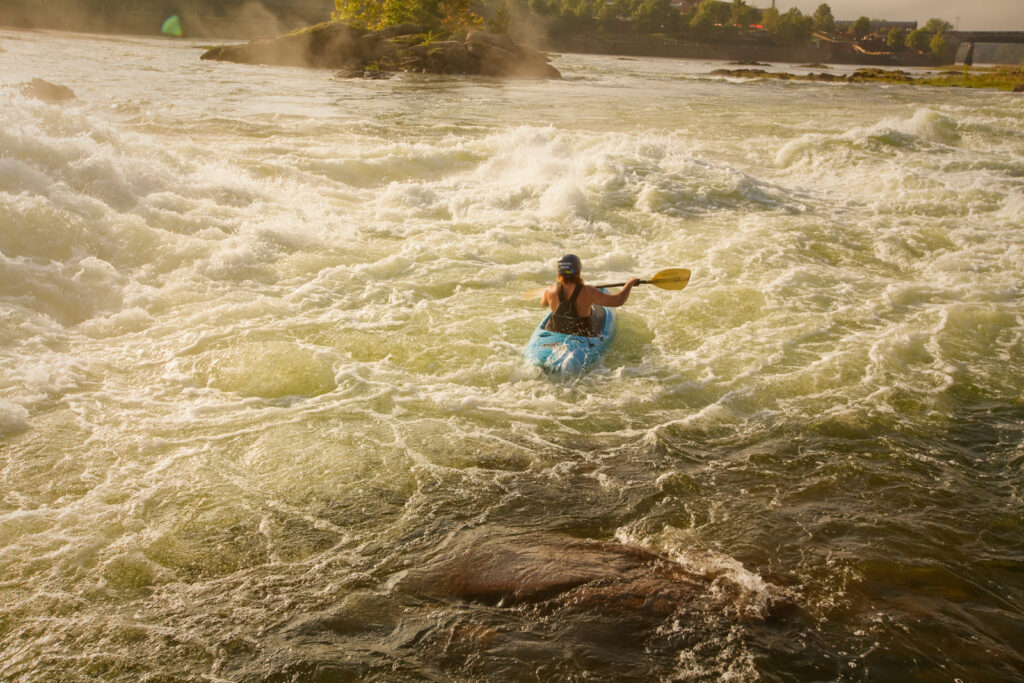
Courtesy of Georgia Department of Economic Development.
Rafts remained the primary boat of choice for southeastern whitewater until the 1950s. At that time fiberglass and other materials developed for the national space program began to be used in the construction of canoes and a “new” type of boat adapted from a Native American design, the kayak. Fiberglass had several advantages over materials previously used in boat construction: it was easily formed into a variety of shapes, and it was relatively strong and extremely lightweight.
Unfortunately, fiberglass often cracked upon impact with rock. After improved plastics and plastic-molding techniques were developed in the 1970s, durable and inexpensive whitewater boats became available.
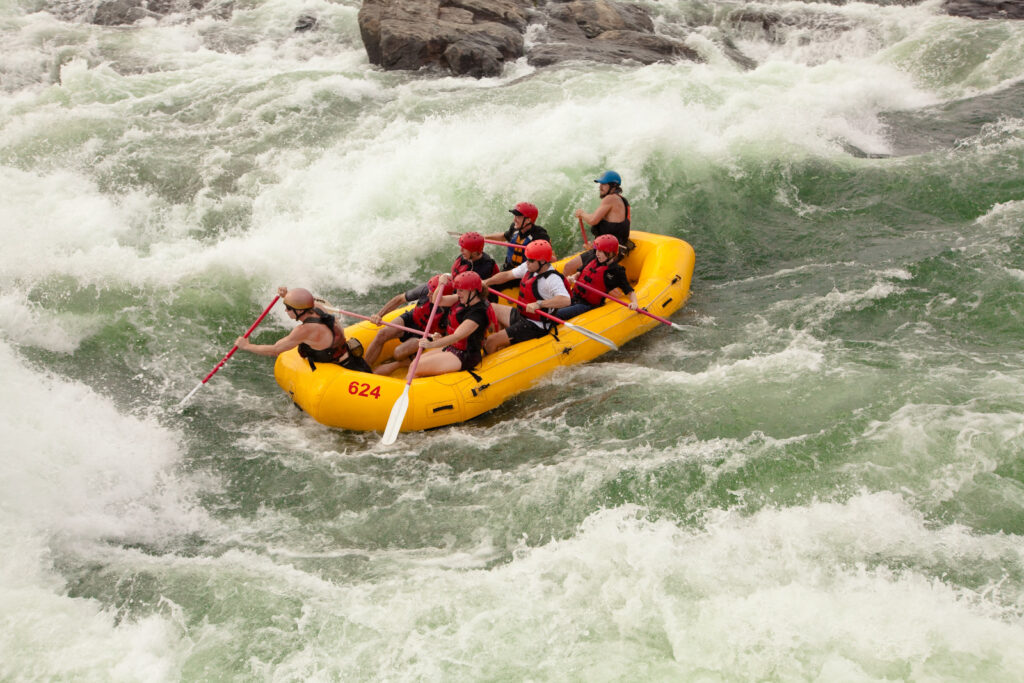
Courtesy of Georgia Department of Economic Development.
Beginning in the late 1970s whitewater clubs sprang up at the University of Georgia and the Georgia Institute of Technology. These clubs, among others, served to introduce many people to the sport, and they continue to do so. The 1972 movie Deliverance, adapted from a novel by James Dickey, was filmed on two Georgia rivers, the Chattooga and the Tallulah, as well as on the Chauga in neighboring South Carolina. This movie sparked much interest in the new sport, and greater numbers of people began paddling Georgia whitewater. Outfitters also began establishing businesses to accommodate people interested in rafting, canoeing, or kayaking in the state.
Safety
Although whitewater paddling is an enjoyable way to experience the majestic scenery of Georgia’s waterways, it is not without risk, and fatalities do occur. To reduce the risk, some safety precautions should be observed. It is extremely inadvisable and in some locations illegal to boat alone; experts strongly advise paddling with a partner or group. At least one member of the party should be familiar with the river being attempted. Furthermore, it is important to “scout” rapids where one’s view might be obstructed from the river by getting out of the boat and evaluating from shore the safest route. It is important to realize when a rapid should be portaged, that is, when the boat should be pulled from the stream and carried around the rough water. Entrapment beneath trees, undercut rocks, or other objects in the river is the most common cause of death in whitewater accidents. Georgia law requires that lifejackets be worn on rivers in the state. Helmets, although not required on all rivers, are also necessary for safety.
An international rating scale for comparing river difficulty was developed using six classes or difficulty levels. Class 1, the easiest level, is defined as fast-moving water with small waves, a few obvious obstructions, and relatively little danger to accidental swimmers. The classes increase in difficulty, culminating in Class 6, which is described as extreme and exploratory. These runs are almost never attempted, even by expert paddlers, and offer extremes of danger and unpredictability. The consequences of a mistake can be severe or fatal.
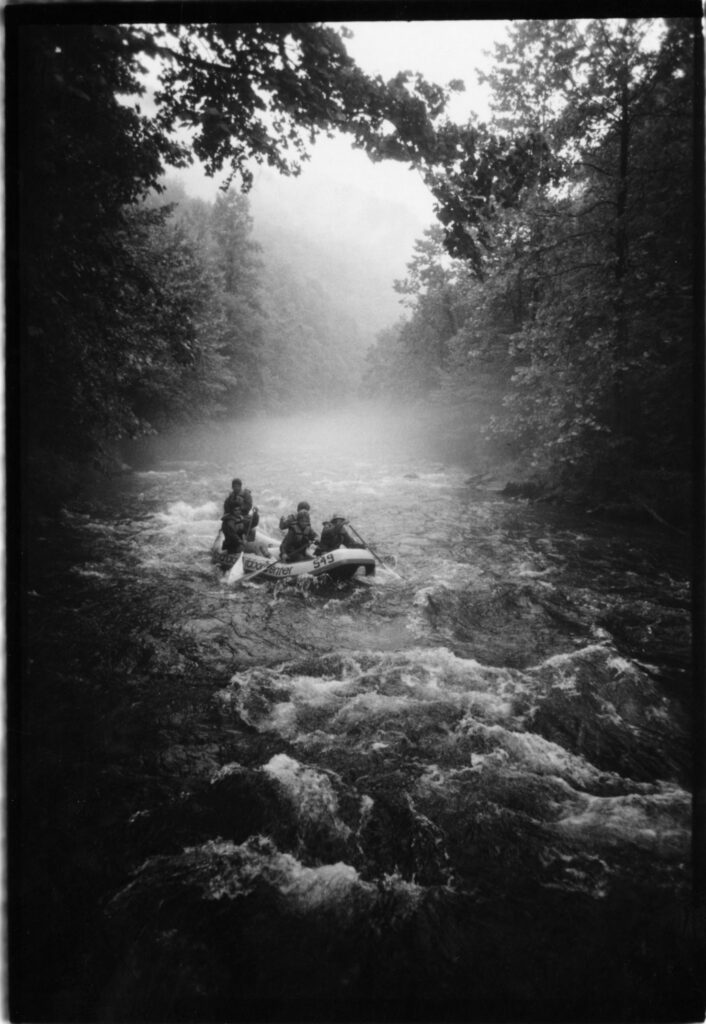
Courtesy of UGA Cooperative Extension Service. Photograph by James D. Strawser
As interest in whitewater paddling has increased, several terms have been developed to describe river phenomena and paddling maneuvers.
eddy: a pocket of water downstream of an obstacle that flows back upstream
ferry: a maneuver used to move back and forth across a river
hole: a swirling vortex of water where the river flows over an obstacle and drops toward the river bottom, leaving a pocket into which upstream current flows
keeper: a dangerous hole that can hold a swimmer or boat for an extended period of time
put-in: the place where the whitewater trip begins
scout: to walk along the bank to inspect a rapid
strainer: an obstacle, such as a tree, that lets water flow through freely but traps swimmers, boats, and debris
take-out: the place where the trip ends
Georgia Treasures
Although Georgia’s whitewater rivers and creeks are far too numerous to describe in detail, two rivers in particular, both in the northeast Georgia mountains near Clayton, deserve special recognition. The crown jewel of Appalachian whitewater, the Chattooga River is one of the few remaining free-flowing streams of substantial size in the Southeast. The river has its source in the mountains of North Carolina and flows south, forming the border between Georgia and South Carolina. Pristine for much of its length, the Chattooga received federal protective status in 1974 under the Wild and Scenic Rivers Act. The Chattooga has been divided into four sections, three of which are available for whitewater paddling. The Chattooga has sections to accommodate all skill levels: Section II is suitable for novices, Section III is suitable for intermediate paddlers, and Section IV is considered an advanced run.
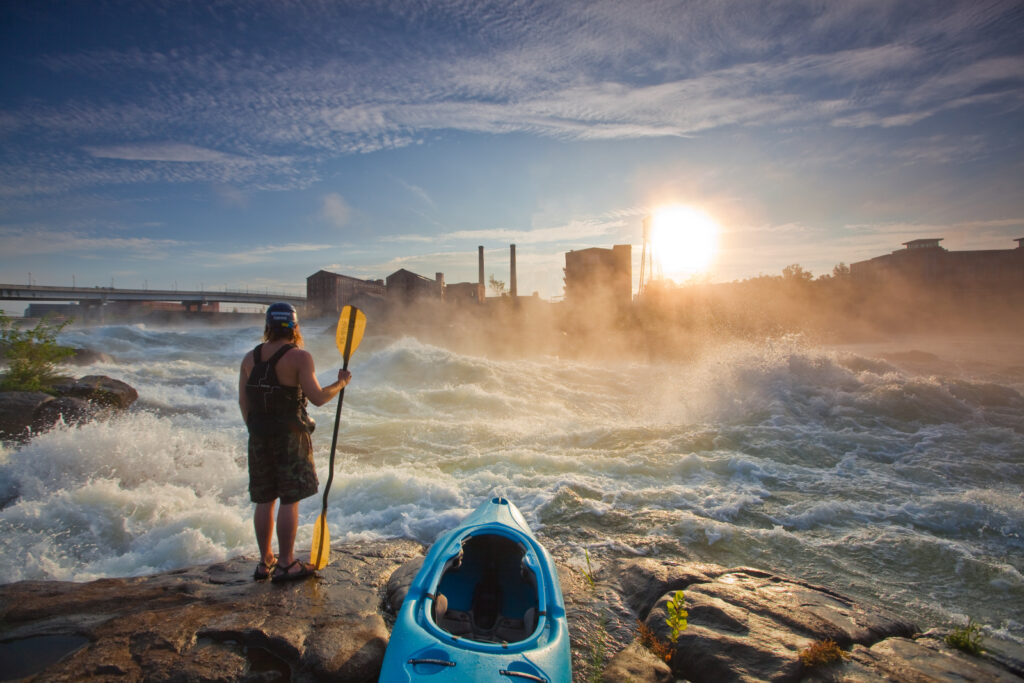
Courtesy of Georgia Department of Economic Development.
The Tallulah River and the gorge through which it flows are among the geological marvels of the Southeast. The Tallulah River is also one of the premier whitewater runs in the world. Located in Rabun County, Tallulah Gorge and the nearby town of Tallulah Falls were once tourist destinations, until a hydroelectric dam completed in 1914 silenced the mighty falls. In 1988 the Georgia Power Company and the federal government reached an agreement allowing recreational releases of water from the dam at the head of the gorge five weekends per year. Overnight a world-class, expert-level whitewater run was reborn. The fall and spring releases in Tallulah Gorge draw whitewater enthusiasts from around the globe as well as hundreds of spectators.
As increasing numbers of paddlers are beginning to discover, whitewater paddling offers a wonderful way to enjoy the natural beauty of Georgia.


